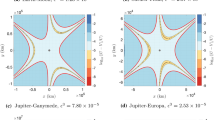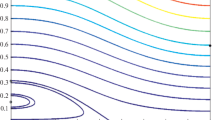Abstract
We propose an approach to the study of the evolution of high-apogee twelve-hour orbits of artificial Earth’s satellites. We describe parameters of the motion model used for the artificial Earth’s satellite such that the principal gravitational perturbations of the Moon and Sun, nonsphericity of the Earth, and perturbations from the light pressure force are approximately taken into account. To solve the system of averaged equations describing the evolution of the orbit parameters of an artificial satellite, we use both numeric and analytic methods. To select initial parameters of the twelve-hour orbit, we assume that the path of the satellite along the surface of the Earth is stable. Results obtained by the analytic method and by the numerical integration of the evolving system are compared. For intervals of several years, we obtain estimates of oscillation periods and amplitudes for orbital elements. To verify the results and estimate the precision of the method, we use the numerical integration of rigorous (not averaged) equations of motion of the artificial satellite: they take into account forces acting on the satellite substantially more completely and precisely. The described method can be applied not only to the investigation of orbit evolutions of artificial satellites of the Earth; it can be applied to the investigation of the orbit evolution for other planets of the Solar system provided that the corresponding research problem will arise in the future and the considered special class of resonance orbits of satellites will be used for that purpose.
Similar content being viewed by others
References
Asyushkin, V.A., Greshilov, P.A., Efanov, V.V., Martynov, M.B., Moisheev, A.A., Nemykin, S.A., Romanov, V.M., and Shevalev, I.L., Avtomaticheskie kosmicheskie apparaty dlya fundamental’nykh i prikladnykh nauchnykh issledovanii (Automatic Spacecrafts for Fundamental and Applied Scientific Researches), Polishchuk, G.M. and Pichkhadze, K.M., Eds., Moscow: MAI-Print, 2010.
Chao, C.C., Applied Orbit Perturbation and Maintenance, El Segundo, CA: Aerospace Press; Reston, VA: American Inst. Aeronautics and Astronautics, 2005.
Chernyavskii, G.M. and Bartenev, V.A., Orbity sputnikov svyazi (Orbits of Communication Satellites), Moscow: Svyaz’, 1978.
Jarnagin, M.P., Expansions in elliptic motion, Astron. Pap. Am. Ephem. Naut. Alm., 1965, vol. 18, pp. 1–659.
Lidov, M.L. and Yarskaya, M.V., Integrable cases in the problem of the evolution of a satellite orbit under the joint effect of an outside body and of the noncentrality of the planetary field, Kosm. Issl., 1974, vol. 12, no. 2, pp. 155–170.
Lidov, M.L. and Solov’ev, A.A., Some qualitative regularities and estimates of the evolution of Molniia-1 type satellite orbits, Kosm. Issl., 1975, vol. 13, no. 6, pp. 795–803.
Solov’ev, A.A., Semi-analytical method for calculating motion of resonance artificial Earth’s satellites with great eccentricity. 1. Algorithm description and experimental results. Gravitational model, Preprint of Institute of Applies Mathematics, USSR Academy of Sciences, 1974a, no. 86.
Solov’ev, A.A., Semi-analytical method for calculating motion of resonance artificial Earth’s satellites with great eccentricity. 2. Applications, Preprint of Institute of Applies Mathematics, USSR Academy of Sciences, 1974b, no. 87.
Subbotin, M.F., Vvedenie v teoreticheskuyu astronomiyu (Introduction to Theoretical Astronomy), Moscow: Nauka, Fizmatlit, 1968.
Vashkov’yak, M.A., Evolution of singular elliptic orbits of synchronous spacecraft, Kosm. Issl., 1991, vol. 29, no. 1, pp. 133–144.
Author information
Authors and Affiliations
Corresponding author
Additional information
Original Russian Text © M.A. Vashkovyak, G.S. Zaslavskii, 2016, published in Astronomicheskii Vestnik, 2016, Vol. 50, No. 5, pp. 388–397.
Rights and permissions
About this article
Cite this article
Vashkovyaka, M.A., Zaslavskii, G.S. Approximate analytic method for high-apogee twelve-hour orbits of artificial Earth’s satellites. Sol Syst Res 50, 368–377 (2016). https://doi.org/10.1134/S0038094616050063
Received:
Published:
Issue Date:
DOI: https://doi.org/10.1134/S0038094616050063




